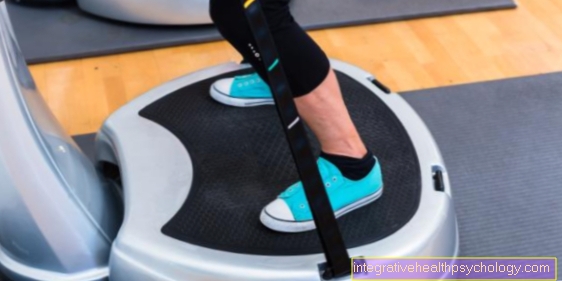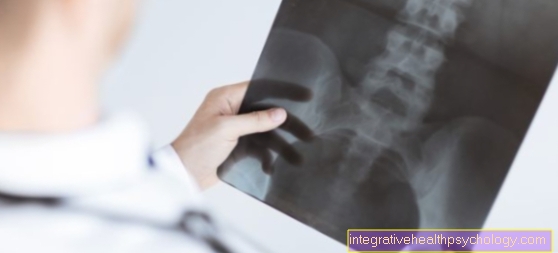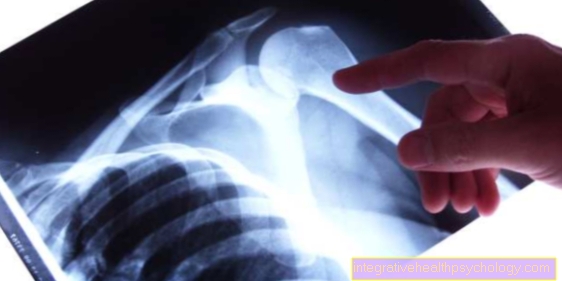Painkiller
What is pain

Pain is our body's alarm signal that is supposed to alert us to danger and to tell us that something is wrong. However, before we feel pain in order to be able to react to it, various processes must take place in the body.
Pain starts somewhere on the body, for example on the finger when we prick ourselves with a needle. On the finger, the injury leads to the release of various substances from the injured cells, irritating a nerve pathway towards the brain. However, the nerve path does not lead directly to the brain, but only to the spinal cord. There it is switched to another path, which then ultimately leads to the brain. In the brain, the nerve tracts from the spinal cord end in special areas, which then trigger the perception and feeling of "pain" in us.
But not all pain is the same and so a person can describe pain as stabbing, dull, throbbing, knocking, light, or even pulling feel. The Kind of pain can often be a Indication of its cause be.
Pain can also lose its warning function and occur for no reason or even disproportionately strong, without the body having suffered any serious injury. The pain lasts longer than six months without cause one speaks of chronic pain. Treat this differently than acute pain and often take one lengthy course and not infrequently requires treatment from a trained person Pain medicine specialist.
Was the first trigger an actual injury that though cured is after which the pain, however, remained is, the brain has a so-called "Pain memory“Trained and feels that the injury is still there. The actually protective function turns into a physically and mentally very stressful state and becomes an illness.
In addition to the pain described above, which should be understood as a warning signal, there are other types of pain, such as this Nerve pain, if the Nerve tractto guide the pain hurt yourself is and such a Continuous signal sends to the brain.
Depending on Place of origin one differentiates in medicine the superficial Pain from the pain of ours internal organs, which we for example at stomach pain feel.
General pain relievers
Painkillers are drugs that preventthat man the Sensation of "pain" perceives, although in many cases the Trigger still present is.
Depending on Site of action of the drugs one differentiates the so-called peripheral (so outside ours central nervous system, for example on the fingers, legs or in the stomach) effective from the central (i.e. central painkillers that work in the spinal cord or directly in the brain). The outside the central nervous system active drugs are further divided into Acid and non-acidic ingredients (according to their chemical formula) as well antispasmodic substances.
The large group of the opiate with your Main representative the Morphine and its descendants, as well as a few other substances. Through this Variety of different groups is one able to Pain directly at the point of origin, or later to stop the transmission in the spinal cord or in the brain. Very useful is also not infrequently one Combination of drugs different points of attack, which then inhibit every possible point of pain development and transmission in order to suppress pain even more effectively.
What kind of pain relievers are there?
The range of pain medication is there very diverse and come for the different causes of pain various pain relievers that are particularly suitable for the respective type of pain. Not all pain relievers are available over the counter and so most of them have to by recipe be prescribed by the doctor. For the most opiate becomes even a Narcotic prescription needed. This is with special requirements and is intended to prevent the abuse of opiates.
A group of drugs that reduce pain prevent directly at the point of origin are said to be named by their chemical appearance non-steroidal, acidic pain relievers (NSAIDs). They include the very well-known active ingredients Acetylsalicylic acid (e.g. aspirin®, ASS), Ibuprofen (e.g. Nurofen®, Neuralgin®) Naproxen (e.g. Dolormin®) and Diclofenac (e.g. Voltaren®). The non-steroidal pain relievers act on the formation of hormonesthat are released in the event of an injury to alert the immune system to the Prostaglandins. The enzymethat plays a role in education is called Cyclooxygenase. Due to this mode of action, this group of painkillers is ideally suited for pain that occurs in this way, such as minor injuries or Joint pain. Since the prostaglandins also at fever and Inflammation Playing a role, these drugs also have an excellent effect on fever and inflammation.
Besides the acidic pain relievers there is still the chemical one non-acidic Painkillers with her two Main representatives paracetamol (Ben-u-ron®) or Metamizole (Novalgin®). you have one similar mode of action like the acidic pain relievers, however, differ in their ability to not effective against inflammation at the same time to be. For Metamizole (Novalgin®) still has the outstanding property at the same time antispasmodic to be. This property makes it optimal drug for cramping abdominal pain, like for example with a Biliary colic or one renal colic occur. At the same time it is that too most effective Drug from the entire group of non-opiates Painkillers that by prescription is available. Paracetamol forms The drug of choice, especially for children, as many other active ingredients such as acetylsalicylic acid (aspirin®) forbidden for children is.
Opiates do not work at the point of origin of the pain, you prevent just that Signal transmitted in the spinal cord will and is perceived in the brain. Drugs from the opiate family work on so-called Opiate receptors. These are located along the pain-conducting nerve tracts in the spinal cord and in the brain. Also the The body itself forms a kind of opiate, the so-called endogenous Endorphins. These worry in the event of severe injuries making sure the body is its own Inhibits pain pathways and the pain doesn't get too big. Only these endorphins in the body ensure that People after serious accidents your Not properly aware of injuries or Women survive childbirth can without passing out from pain. The administration of additional opiates as medication activates this system to the maximum and, on the one hand, the pain no longer reaches the brain or is additionally weakened there.
What are the side effects of pain medication?
Every group of painkillers has its special side effects. The side effects of the Non-steroidal pain relievers result from their mode of action. The above mentioned Cyclooxygenases also play in other processes in the body, especially the Formation of protective gastric mucus an important role. Usually prevails at the Inside of the stomach lining a balance of protective gastric mucus and necessary for digestion but for the gastric mucosa harmful stomach acid. If the non-steroidal anti-inflammatory drugs are used to inhibit the formation of the protective gastric mucus stomach acid gains the upper hand and can Attack stomach wall. It arises with long duration of being overweight Stomach ulcer or duodenal ulcer, which in extreme cases can be life-threatening Gastric perforation can lead.
This Main side effect of non-steroidal anti-inflammatory drugs can after just a few income occur. Because of this you should vulnerable patients always a so-called Stomach protectione.g. one Proton pump inhibitors, take in addition. Particularly at risk are patients who use acetylsalicylic acid (aspirin®), as these also have the Properties of our platelets changedso that these can no longer clump together, which in turn is a increased bleeding after injuries entails.
Another not to be neglected side effect of long-term use is that damaging effect on the heart and kidneys. Patients with problems and diseases of any of these organs should use non-steroidal pain relievers only take after medical consultation or on medical advice. this applies also for patients with lung disease, since the inhibition of cyclooxygenase also leads to the preponderance of other substances Change alveoli and so those Make breathing difficult and in asthmatics in extreme cases trigger an asthma attack can.
Are opiates when used safely, very effective and easy to control. One of the most common Side effectsthat affects many patients are nausea and dizziness. Both of them are due to the effects in the brain. This effect also causes a headache and in rare cases one Drowsiness. Next occurs frequently constipation on. This is through a kind Cramp in the bowel (Spasticity) conditional and feels a lack of bowel movements. Remedy here a co-prescribed laxative, a so-called Laxative. If none has been prescribed by prescription, this should be done as soon as possible when the constipation occurs.
Lots other side effects how Changes in appetite, mood changes, impaired kidney function, seizures, confusion, nightmares, altered sensory perceptions, urination disorders are due to the diverse effects of opiates on various parts of the body. These and many other side effects are there very rare and can in the Leaflet can be read. Even the dreaded one Respiratory paralysis is taking opiates when used properly very rare, the risk increases but with careless Combinations with sleeping pills or alcohol.
How are pain relievers used?
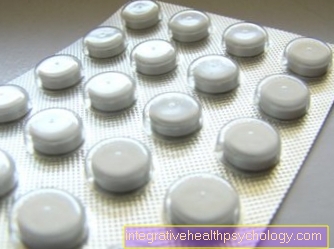
Painkillers are available in many different forms due to their versatility. Above all, the classic tablet form. Opiates are often given in the so-called sustained release form. Retard form means that the tablet is coated with a protective layer against stomach acid and the active ingredient is only released very slowly in the small intestine. This ensures a long-lasting effect of the opiates with permanent pain. The normal tablet form or the drop form, on the other hand, work very quickly, but only very briefly and they are therefore often used against so-called "pain peaks" in the event of sudden, severe pain attacks.
Effervescent tablets for dissolving or drops are an alternative to tablets. Suppositories have also proven themselves for children. For severe pain, most preparations are also available as injection solutions for direct injection into the muscle or a vein. With this form of administration, on the one hand, larger amounts can be introduced into the body and, on the other hand, the effect occurs many times faster. Fentanyl patches, which are stuck to the skin and then release their active ingredient for 72 hours, have proven to be effective for the opiate.
Painkillers in Pregnancy
The question about Painkillers in Pregnancy can not always answered absolutely become. A distinction must always be made between single intake and permanent intake. The following applies: "As much as necessary, as little as possible“. Before taking should always be one doctor be visited and discussed.
Acetylsalicylic acid (aspirin®) and other non-steroidal pain relievers should go through anti-labor properties no longer in the last trimester of pregnancy be used. You own additionally nor the property that To close the child's connection between the large child's blood vessels in the lungs and the circulatory system and are held responsible for various heart defects and kidney damage.
Only the active ingredient Ibuprofen from this group can according to the current state of knowledge used up to the 28th week of pregnancy become.
As Means of choice against pain throughout pregnancy is generally out Paracetamol recommended. However, this should also only after consultation applied with a doctor and the maximum daily dose must be strictly observed.
opiate are in pregnancy and breastfeeding not absolutely forbidden. According to many literature references, individual doses when urgently needed have no harmful effect on the unborn child. Only that permanent ingestion should be avoided and be switched to ibuprofen and paracetamol up to the 30th week of pregnancy. Reason is Transfer of opiates into the child's cycle through the plaster cake. In the child's cycle, opiates then develop the same effects as in the mother and in the worst case it can lead to "Addiction" come. Long-term use can be used for the child after the birth sudden withdrawal with all the effects of opiate withdrawal and it can be how in adults with an overdose to respiratory failure come.
Painkillers while breastfeeding
Also for them Lactation there is a lot to consider when it comes to taking medication, as most of the medication about the Breast milk is passed on to the child and unfolds its effect there. Preferably Taking fast-acting drugs after breastfeeding one so that most of the active ingredient is up not at all in the mother's blood for the next breastfeeding and therefore no longer passes into breast milk.
As in pregnancy, the same applies to breastfeeding: "As much as necessary, as little as possible". The same applies to non-opiates as in pregnancy Paracetamol as the drug of choice against pain. Alternatively, ibuprofen can be usedwhich even with the infants represents the means of choice and thus no harm to the child caused by transmission through breast milk. For the opiate Also applies during breastfeeding: Experience has shown that isolated doses are not a problem permanent ingestion should be avoidedeven if only small amounts of the opiates pass into breast milk.
Painkillers and alcohol - are they compatible?
Apply pain medication when taken safely and correctly as very safe. Painkillers and alcohol are however not a recommended combination, because it holds many dangers and risksthat partly even life threatening can be when, for example, highly effective opiates are taken with alcohol. With other active ingredients, however, it is only necessary to weigh the risks and possibly only reduce the amount of alcohol to the minimum necessary.
Problems when combining alcohol and painkillers, they do often similar points of attack in the brain or a similar route of breakdown via the liver and kidneys. This is where mutual interactions lead Poisoning with one or the other combination partner. Due to the competition for precisely those points of attack the effects of the two counterparties increase each other. opiate can already in much lower doses extreme side effects as a Respiratory paralysis cause which under normal circumstances would not be expected under any circumstances at the dose used.
Non-steroidal pain relievers (NSAID = Ibuprofen, Voltaren, Diclofenac etc.) unfold the Interactions mainly in the stomachwhere the balance is in favor of the medication harmful stomach acid is shifted. Alcohol further shifts this balance towards stomach acid and the risk for one Gastric or duodenal ulcer or even one life-threatening gastric rupture grows.
Even with the non-steroidal painkillers the joint breakdown with the alcohol in the liver in the foreground and here too the effect can be mutually strengthened or weakened become.
Read more about this:
- Ibuprofen and alcohol
- Diclofenac and alcohol
It can pain despite taking medication exist and the Risk of overdosing grows through further income. Through the Double burden runs the liver also danger overloaded to become and it can be too serious Liver damage up to the total Liver failure come when the combination is administered over a very long period of time.
For the treatment of Pain after drinking alcohol The pain reliever Aspirin® and a sufficient supply of fluids are particularly suitable.
Pain relievers after surgery
Therapy for pain after an operation is there depending on the type of surgery, because different interventions cause very different degrees of pain. So are increased pain after surgery in the chest or abdomen to be expected than with smaller operations on arms or legs.
While for minor interventions already a Painkiller may be sufficient to relieve pain, so require major abdominal surgeryn one multi-layered pain therapywhich consists of several building blocks. target however, every therapy is always that Freedom from pain of the patient. It is often possible to produce these using a combination of different processes.
Pain has been shown to be bad for recovery and unnecessarily burden the person concerned. Therapy for pain after surgery is used individually tailored to each patient and so find next to the type of surgery Basic illnesses, previous medications or age and the previous "pain history" an important role in choosing the right pain therapy.
During the operation is the patient through the strong pain relievers as part of every anesthetic protected from pain. However, after the operation, the pain would come up quickly from the procedure. That's why pain therapy begins usually yes during the operationwhere the patient already receives the first dose of pain medication in order to wake up from anesthesia as painlessly as possible. Here will be often higher doses of metamizole or paracetamol from the group of non-opiates. The pain management is then continued in the recovery room through the regular administration of painkillers. Come here often opiates for use.
For the days after the operation and around post-operative pain ideally, the doctors should treat the patient in consultation with the patient a scheme developed before the operation, which brings the patient freedom from pain through the optimal combination of drugs. If severe pain or long-lasting pain is to be expected, the system has one Pain catheter into the vein or spinal cord (as a so-called Peridual catheter) proven. About the catheter and a connected pump become consistently small amounts of pain medication released to keep the patient painless. If so-called "pain peaks" nevertheless occur selectively, the patient can use one Request an extra dose of medication using the button on the pump. An overdose is by a preset maximum dose locked out.
Pain after surgery on arms or legs can through Nerve blocks be achieved. So can a Pain catheter also directly to the nerve of the arm The transmission from the nerve to the brain is blocked.

.jpg)



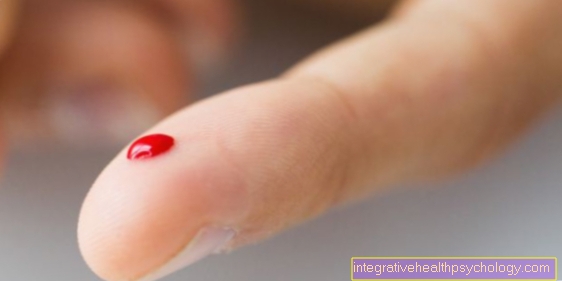







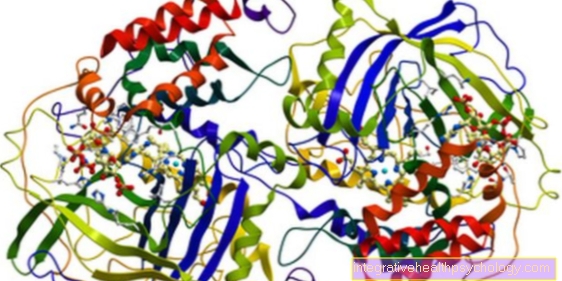
.jpg)


